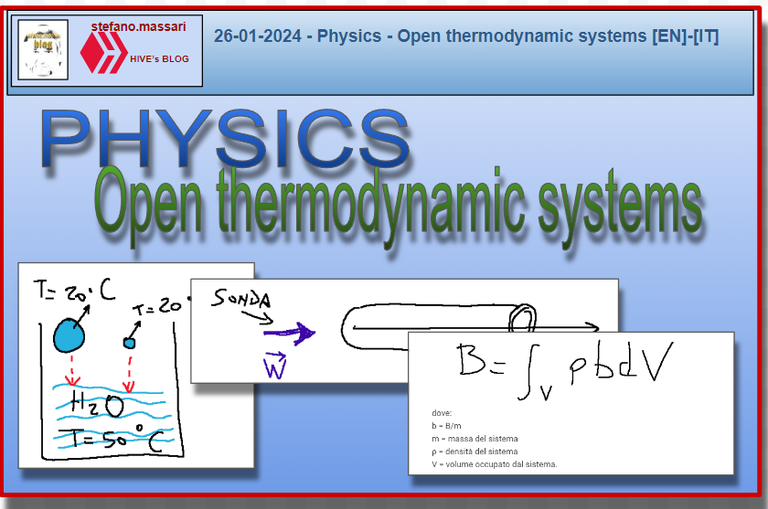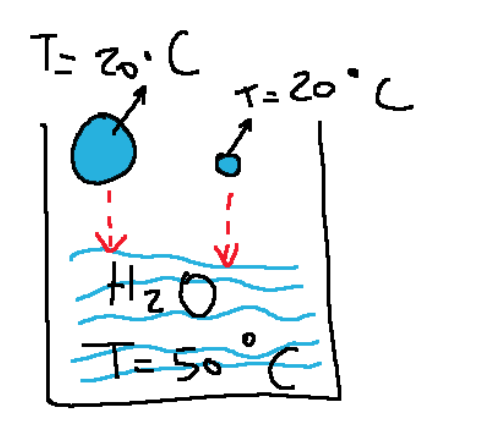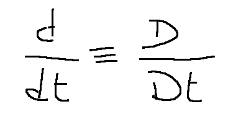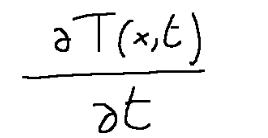26-01-2024 - Physics - Open thermodynamic systems [EN]-[IT]

~~~ La versione in italiano inizia subito dopo la versione in inglese ~~~
ENGLISH
26-01-2024 - Physics - Open thermodynamic systems [EN]-[IT]
Open thermodynamic systems
Open system: if there are exchanges of energy and matter between the system and the environment, then we talk about an open system.
Water boiling in a pan is an excellent example of an open system, in fact steam is water that leaves the system to disperse into the environment and will never return to the system.
An open thermodynamic system is a system that exchanges energy, i.e. work or heat, but also matter, with the environment. If we think about the system of water boiling in the pot proposed above, we fall precisely into this case, where the matter is exchanged with the environment, in this case the water vapor that is dispersed from the pot into the environment.
Local equilibrium hypothesis
The local equilibrium hypothesis tells us that if our system is equal to a small volume made up of a point with its surroundings, it will reach the final equilibrium conditions instantly. That is, the smaller things are, the faster thermal equilibrium is reached.
In the example below we see two 20° T-shaped spheres that will be immersed in water at 50°. The smaller sphere will reach thermal equilibrium first.

Substantial, convective, local derivative
To explain this, let's imagine we have a tube with different temperatures inside.
see image below

Now imagine what an observer moving inside the tube with constant speed W would measure.
To make this measurement we can imagine two points of view:
-Eulerian point of view, that is, taking a reference space, placing yourself in some fixed points and measuring the temperature, as if we were taking photographs.
-Lagrangian point of view, it means moving with chosen particles to measure their temperature as their position varies.
If we use the Eulerian point of view we will also have three derivatives
1-substantial derivative
The sum of the following derivatives, referred to an elementary control mass.

2-local derivative
Where the observer is stopped at one point

3-convective derivative
In which the observer moves with speed w together with the elementary control mass

Transport theorem
The transport theorem allows us to move from the formulation in M.C. terms. (control mass) to that relating to the V.C. (control volume) for a generic extensive quantity B of the system.

Where:
b = B/m
m = mass of the system
ρ = density of the system
V = volume occupied by the system.
Conclusions
The smaller a system is in terms of volume, the faster it can reach thermodynamic equilibrium conditions
Request
Had you already studied the Local Equilibrium Hypothesis in the past? Do you like or have you liked thermodynamics in the past?
THE END

26-01-2024 - Fisica - Sistemi termodinamici aperti [EN]-[IT]
Sistemi termodinamici aperti
Sistema aperto: se tra il sistema e l'ambiente ci sono scambi di energia e materia, allora parleremo di sistema aperto.
L'acqua che bolle in una pentola costituisce un ottimo esempio di sistema aperto, infatti il vapore è acqua che abbandona il sistema per disperdersi nell'ambiente e non tornerà più nel sistema.
Un sistema termodinamico aperto è un sistema che scambia con l’ambiente energia, cioè lavoro o calore, ma anche materia. Se pensiamo al sistema dell’acqua che bolle in pentola proposto prima ricadiamo proprio in questo caso, dove la materia viene scambiata con l’ambiente, in questo caso il vapore acqueo che dalla pentola si disperde nell’ambiente.
Ipotesi dell’equilibrio locale
L’ipotesi di equilibrio locale ci dice che se il nostro sistema risulta pari a un volumetto costituito da un punto con il suo intorno, esso si porterà nelle condizioni finali di equilibrio istantaneamente. Cioè più piccole sono le cose e più in fretta si raggiunge l’equilibrio termico.
Nell’esempio qui sotto riportato vediamo due sfere a T di 20° che verranno immerse in acqua a 50°. La sfera più piccola raggiungerà prima l’equilibrio termico.

Derivata sostanziale, convettiva, locale
Per spiegare questo immaginiamo di avere un tubo con al suo interno temperature diverse.
vedi immagine qui sotto riportata

Immaginiamo ora cosa misurerebbe un osservatore che si muove all’interno del tubo con velocità costante W.
Per fare questa misurazione possiamo immaginare due punti di vista:
-punto di vista euleriano, cioè prendere uno spazio di riferimento, mettersi in alcuni punti fissi e misurare la temperatura, come se facessimo delle fotografie.
-punto di vista lagrangiano, significa muoversi con delle particelle scelte per misurare la loro temperatura al variare della loro posizione.
Se usiamo il punto di vista euleriano avremo inoltre tre derivate
1-derivata sostanziale
La somma delle derivate seguenti, riferita ad una massa di controllo elementare.

2-derivata locale
Dove l’osservatore è fermo in un punto

3-derivata convettiva
Nella quale l’osservatore si muove con velocità w insieme alla massa di controllo elementare

Teorema del trasporto
Il teorema del trasporto consente di passare dalla formulazione in termini M.C. (massa di controllo) a quella relativa al V.C. (volume di controllo) per una generica grandezza estensiva B del sistema.

dove:
b = B/m
m = massa del sistema
ρ = densità del sistema
V = volume occupato dal sistema.
Conclusioni
Più un sistema è piccolo in termini di volume e più velocemente riesce a portarsi nelle condizioni di equilibrio termodinamico
Domanda
Avevate già studiato in passato l'Ipotesi dell’equilibrio locale? Vi piace o vi è piaciuta in passato la termodinamica?
THE END
I always love and enjoy the thermodynamics system of body
One of the things here that I didn't understand very well is the transport theorem which allows you to move from the formulation in terms of control mass to that relating to the control volume. But the possibility of doing this fascinates me. Thanks for stopping by
In open thermodynamic systems we can measure temperatures in two ways. The two approaches are equivalent: one is the Eulerian point of view, the second point of view is the Lagrangian one.
Thanks for sharing this lesson on open thermodynamic systems. It was interesting. I guess this is one of the principles taken into consideration when piston engines are fabricated. Have a great day.
You're right, in my opinion these studies were fundamental for the internal combustion engine. These thermodynamic studies were of great importance during the industrial revolution. I agree
This is an amazing mass
Thanks for it!
I find open thermodynamic systems very complicated. There are different ways to analyze them. One of these is the Lagrangian point of view, that is, choosing particles, moving with them and measuring their temperature as their position varies. Thanks for stopping by
!discovery 30
@tipu curate
Upvoted 👌 (Mana: 0/44) Liquid rewards.
Attualmente ho perso un poco di followers a fare questi post tecnici, ma sono contento di portare questi contenuti in HIVE.. sicuramente la mia mossa non è redditizia, ma spero di offrire contenuti "diversi" da tutto il resto, contenuti che in pochi vorrebbero fare.. proprio perché non rendono. Grazie e ancora grazie per il tuo supporto costante.
This post was shared and voted inside the discord by the curators team of discovery-it
Join our Community and follow our Curation Trail
Discovery-it is also a Witness, vote for us here
Delegate to us for passive income. Check our 80% fee-back Program
Ciò che mi piaceva di più della termodinamica era il concetto di entropia.